he crisis of 1935
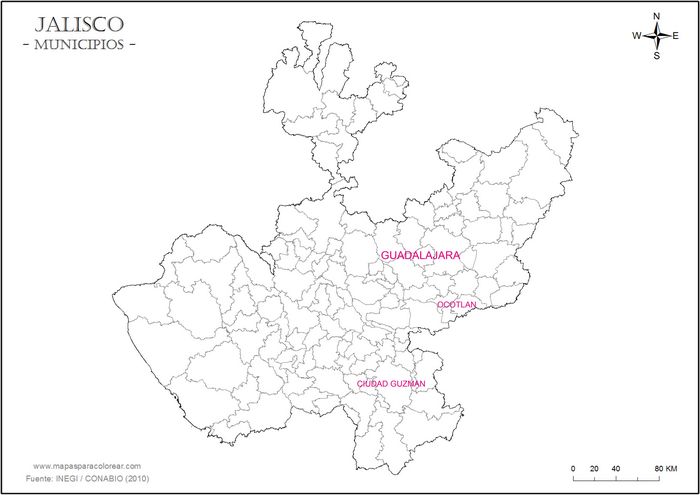
Twice in the twentieth century, in 1935 and again in 1943, Mexico had to resort to the issue of bearer cheques (cheques al portador) to overcome a temporary shortage of small change, caused by the disappearance of silver coins.
This method had been used during the Mexican Revolution, and occasionally since in a few locations, but in these two instances the phenomenon was nationwide. Although some cheques were issued by private businesses for their own employees, the usual procedure was for the local Chamber of Commerce (Cámara Nacional de Comercio) to contract with the local banking institutions. The Chamber would deposit a sum of money to guarantee the cheques and recoup its money when it sold the cheques in bulk to businesses that needed them: the bank would use the deposit to redeem the cheques when they were handed in (originally in multiples of five pesos since that was the smallest banknote, but when the new Banco de México $1 notes arrived, they could redeem smaller amounts).
This procedure could be considered to breach the Federal Government’s monopoly on issuing paper currency and there were occasional complaints but the Secretaría de Hacienda acknowledged the dire circumstances. Thus on 5 May 1935 the Secretaría declared the issue of $1 cheques de caja legal. On 16 May 1935 Secretario de Hacienda Narciso Bassols suggested that the Dirección de Correos y Telégrafos tell all their offices to accept the $1 and $2 cheques al portador that had been issued by local Cámaras de Comercio.
The cheques were of voluntary acceptance, and occasionally public officers refused to accept them, but generally, as they were redeemable on demand, they were readily accepted and helped greatly to relieve the crisis.
Occasionally, existing cheques were overprinted “AL PORTADOR” and with a discrete denomination, but more usually, because of the volume needed, the cheques were specially printed. Though, as can be seen, they followed a simple design.
The 1935 crisis began when the United States passed its American Silver Purchase Act on 19 June 1934: this caused the price of silver to increase and as a result, in Mexico, silver coins began to be hoarded to be remelted at a profit. On 25 April 1935 the Mexican government reacted with a series of reforms, changing the fineness of its coinage, and withdrawing silver coins from circulation. It had ordered 50c coins (tostones) and $1 Banco de México notes from the United States but until these arrived the sudden shortage of small change led to these “necessity notes”.
When the crisis passed most of these cheques were redeemed (out of $10,000 issued by the Uníon Nacional de Industria y Comercio in Guadalajara only $18 was not handed in) and so survivors are extremely rare.
Guadalajara
Cámara Nacional de Comercio
In Guadalajara on 29 April a meeting at the offices of the Banco Industrial de Jalisco, on avenida 16 de Septiembre, was attended by the manager of the bank, Antonio Pérez Orñoz and its board of directorsCarlos Dávalos, presidente; Carlos Hering, vicepresidente; Ricardo Aguilar, secretario; Felipe Iteves, comisario, Félix Díaz, the manager of the branch of the Banco de México, Trinidad Pérez Vargas, the president of the Cámara Nacional de Comercio, Industria y Minería, and Efrain González Luna, the Cámara’s lawyer. They agreed that the Cámara would issue cheques for $1, $2, $3 and $4, exchangeable in the banks of the city, and the Cámara issued a notice to that effect. Immediately afterwards Félix Díaz summoned a meeting of the manager of the city’s banks, Antonio Pérez Orozco, of the Banco Industrial de Jalisco; José Pintado, of the Banco Nacional de México; Salvador Veytia, of the Banco Mercantil; Juan Francisco Ortiz, of the Banco Agrícola Ejidal and Francisco Ibarra, of the Banco Refaccionario, to agree the details. The Cámara agreed to issue $50,000 for immediate useEl Informador, Año XVIII, Tomo LXVII, Núm. 6354, 30 April 1935. There was a slight hiccough when Enrique Karg, the inspector of the Comisión Nacional Bancaria, who happened to be in the city, suggested that the proposal might be illegal, but telephone calls with the Secretaría de Hacienda y Crédito Público and the Confederación de Cámaras de Comercio led to a telegram from the Secretario Hacienda, Narciso Bassols, permitting the issueEl Informador, Año XVIII, Tomo LXVII, Núm. 6355, 1 May 1935.
In fact the Cámara issued cheques in five denominations drawn on five local banks: the local branch of the Banco Nacional de México ($1); the Banco de México ($1 and $2.50); the Banco Mercantil de Guadalajara ($1, $2 and $3); the Banco Industrial de Jalisco ($1, $2 and $4) and the Banco Refaccionario de JaliscoThe Banco Refaccionario de Jalisco opened its doors on 28 May 1930 at the corners of 16 de Septiembre and Madero. Its Sub-gerente was Francisco Ibarra, and Cajero-Contador was José V. Alcalá. The board was composed of Federico J. Castro as Presidente, Rafael M. Salazar as Vicepresidente, Carlos Dávalos as Secretario, and Ignacio F. Sahagún as Tesorero. Gastón Boyer, Xavier García de Quevedo and José Santiago Camarena were Vocales, whike Ricardo Aguilar and Julio Sierra Souza were Comisarios (El Informador, Ano XXII, Tomo LXXVIII, Núm. 7,485, 1 June 1939 ($1, $2 and $3). The total issued by each bank was:
| Sucursal del Banco Nacional de México, S. A. en Guadalajara | $ 30,000 |
| Banco de México, S.A | 55,000 |
| Banco Mercantil de Guadalajara, S. A. | 47,000 |
| Banco Industrial de Jalisco, S. A. | 37,000 |
| Banco Refaccionario de Jalisco, S.A. | 51,000 |
| $ 220,000 |
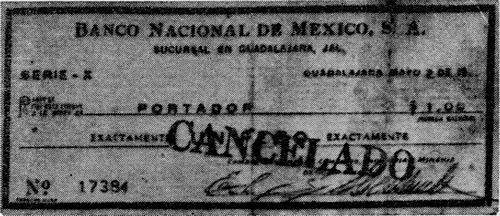
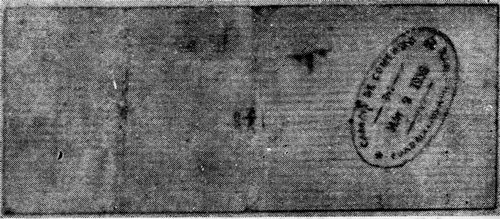
$14,000 of cheques for $1 were put into circulation on 2 MayEl Informador, Año XVIII, Tomo LXVII, Núm. 6358, 3 May 1935 and a further $15,000 in $1, $2, $3 and $4 notes on 3 MayEl Informador, Año XVIII, Tomo LXVII, Núm. 6357, 4 May 1935. $2.50 notes followed and by 5 May almost $50,000 were in circulationEl Informador, Año XVIII, Tomo LXVII, Núm. 6358, 5 May 1935 and by 9 May over $70,000El Informador, Año XVIII, Tomo LXVII, Núm. 6362, 9 May 1935.
In summary
| drawn on | date of issue | date on note | Series | from | to | total number |
total value |
||
| Banco Nacional de México | 2 May 1935 | $1 | X | includes number 17384 | |||||
| 30,000.00 | |||||||||
| Banco de México | $1 | ||||||||
| 4 May 1935 | $2.50 | ||||||||
| 55,000.00 | |||||||||
| Banco Mercantil de Guadalajara | $1 | ||||||||
| $2 | |||||||||
| $3 | |||||||||
| 47,000.00 | |||||||||
| Banco Industrial de Jalisco | $1 | ||||||||
| $2 | |||||||||
| $4 | |||||||||
| 37,000.00 | |||||||||
| Banco Refaccionario de Jalisco | $1 | ||||||||
| $2 | |||||||||
| $3 | |||||||||
| 51,000.00 |
The notes were signed by members of the board (Mesa Directiva) of the Cámara Nacional de Comercio. The $1 note drawn on the Banco Nacional de México illustrated above was signed by E. Sapién and L. G. Castañeda. Others were signed by Felipe Reyes, Ramón J. Fregoso, Hans Forstner, Salvador Mejía, J. Trinidad Pérez Vargas, José Pintado, Gastón Boyer, Modesto Barreto and Pedro Martínez Rivas.
|
Modesto Barreto was on the town council (ayuntamiento) in 1920. He was a property developer and in 19[ ] he contributed to the blighting of the centre of Guadalajara, by purchasing the old Casas Consistoriales, in the calle Morelos, from the state government, demolishing them and building the “dissonant and unfortunate” Edificio Mercantil, to house the La Nacional insurance company, and offices for attorneys, doctors and dentists. The Edificio was in turn compulsorily purchased and demolished to make way for further development. |
|
|
He was elected to the board of the Cámara de Comercio y Minería in 1923El Informador, Ano VII, Tomo XXIII, Núm. 2,270, 23 December 1923 and was a lifetime member. He served as manager of the important firm of L. Gas y Cía, Sucrs, owners of “La Ciudad de México”. He was on the board of the Banco Refaccionario de Jalisco, when it was inaugurated on 5 May 1930, and in 1939 was on the board of the Compañía Industrial de GuadalajaraEl Informador, Ano XXII, Tomo LXXVIII, Núm. 7,485, 1 June 1939. He was nominated honorary consul of Belgium in Guadalajara in September 1934El Informador, Ano XVII, Tomo LXIV, Núm 6,137, 25 September 1934 and served from January 1940 to August 1943. He died on 6 March 1948 in GuadalajaraEl Informador, Ano XXXI, Tomo CXIII, Núm. 10,647, 7 March 1948. |
|
|
He began working for the Compañía Hidroelectrica e Irrigadora de Chapala in 1913, earning one peso a day El Informador, Año XVI, Tomo LIX, Núm. 5,667, 11 June 1933, and rose to be vice-president by 1930 and was appointed president-gerente of the company, by then called Compañía Eléctrica Chapalain, in June 1933ibid.. He died of a heart attack on 20 October, 1955, at the age of 63. |
|
| Hans Forstner | |
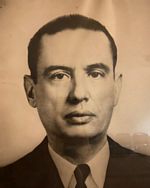 Ramón J. Fregoso Gil was born on 8 June 1891 in Tenamaxtlán, Jalisco. He founded Fregoso stationery. He twice served as president of the Club Deportivo Guadalajara, the first time from 1915 to 1918 and the second from 1926 to 1927. On several occasions he held the positions of president and board member of the Guadalajara Chamber of Commerce, and was also a director of the Banco de Jalisco, president of the Consejo Social de Cooperación para el Desarrollo Urbano in 1945-1947 and vice president of the Board of Directors of the Sugar AssociationEl Informador, 5 September 1950. Ramón J. Fregoso Gil was born on 8 June 1891 in Tenamaxtlán, Jalisco. He founded Fregoso stationery. He twice served as president of the Club Deportivo Guadalajara, the first time from 1915 to 1918 and the second from 1926 to 1927. On several occasions he held the positions of president and board member of the Guadalajara Chamber of Commerce, and was also a director of the Banco de Jalisco, president of the Consejo Social de Cooperación para el Desarrollo Urbano in 1945-1947 and vice president of the Board of Directors of the Sugar AssociationEl Informador, 5 September 1950. |
|
|
He was an industrialist and Presidente of the Consejo de Administración of the Banco de Comercio de Guadalajara. He was director general of Multibanco Comermex, S.A. The Spanish-born businessman Eloy S. Vallina García first established the Banco Mercantil de Chihuahua in 1925 and then founded the Banco Comercial Mexicano in 1934. After Eloy Vallina García’s death, his son Eloy Vallina Lagüera took control of the companies and transformed the bank into Multibanco Comermex. The institution was finally nationalized by the government of President José López Portillo in the well-known "nationalization of banks in Mexico," an operation carried out by the government to face the crisis exacerbated by the country's enormous foreign debt., from 1969 to 1977 and in 1974 was elected Presidente of the Asociación de Banqueros de México. He died in Guadalajara on 16 August 1980El Informador, Año LXIII, Tomo CCXLIV, Núm. 22,474, 17 August 1980. |
|
| Salvador Mejía was treasurer of the Cámara Nacional de Comercio in 1932El Informador, Año XV, Tomo LVI, Núm. 5,331, 10 July 1932. | |
| J. Trinidad Pérez Vargas owned the "El Progreso" vegetable oil factory. | |
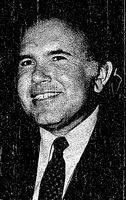 José Pintado Rivero was manager of the Guadalajara branch of the Banco Nacional de MéxicoEl Informador, Año XXIX, Tomo CVI, Núm. 9,975, 1 May 1946. José Pintado Rivero was manager of the Guadalajara branch of the Banco Nacional de MéxicoEl Informador, Año XXIX, Tomo CVI, Núm. 9,975, 1 May 1946. |
|
| Felipe Reyes | |
| Elías Sapién |
Counterfeit notes
On 4 June counterfeits of the $2 cheque drawn on the Banco Refaccionario de Jalisco had been recognized and the Cámara and banks decided to withdraw the chequesEl Informador, Año XVIII, Tomo LXVII, Núm. 6390, 6 June 1935. The characteristics of the counterfeit $2 cheque were:
| GENUINE | COUNTERFEIT |
| printed on green paper | on yellow paper |
| “Banco Refaccionario de Jalisco” in inclined type | in straight type |
| “P” of “PAGUESE” has [ ] (rasgo en esphal) | “P” does not have |
| “Páguese por este cheque al portador” in larger type | |
| signatures badly imitated | |
| On seal on reverse space between lines of “Cámara Nacional de Comercio de Guadalajara” is greater | |
| Space between “Tesorería” and edge of seal is greater | |
| “$” | “S” with a line inked in |
| Numbered 42642 |
By 7 July only eight counterfeits had been discovered, as the attempt had obviously been frustratedEl Informador, Año XVIII, Tomo LXVII, Núm. 6392, 8 June 1935.
Although the cheques were being withdraw, demand remained and in first week of June $11,000 in new cheques was issued, bringing the total in circulation to just over $70,000El Informador, Año XVIII, Tomo LXVII, Núm. 6394, 10 June 1935.
Sucesores de Gas y Cia., S. A.
In the second half of the 19th century French immigrants arrived in Guadalajara with little to no capital, and through credit lines and the social capital of their family, and company networks, started making their way in the regional market. Through reinvesting their earnings, they increased their capital shares, expanded their companies and diversified their investments.
The department store, "La Ciudad de México", on the corner of calle San Francisco (today 16 de Septiembre) and calle Pedro Moreno, was founded in 1880 by the Frenchmen Adrien Berlie and Eugène Cogordan. On 3 September 1880 Berlie transferred the store to Louis Gas and Félix Cogordan, as the firm Gas y Cogordan. Félix Cogordan died on 18 December 1891, and four new partners, including Louis (who though the major partner was based in France) and Antoine Gas, formed a new company, L. Gas y Compañía. On 23 February 1897 the company was restructured to include Louis and Antoine Gas, Eugène Cuzin and Benjamin Teissier, a relative of Cuzin.
Between 1890 and 1900 L. Gas y Compañía was a major investor in the Compañía Industrial de Jalisco and in the Banco de Jalisco. In June 1910 it joined with Brun y Cía. and the Banco de Jalisco to form the Compañía de Fomento y Bienes Raíces de Guadalajara, which also included Aurelio González Hermosillo, Abraham Gallardo and José Pacheco. In 1907 the members of de L. Gas y Cía. were still Louis and Antoine Gas, Eugène Cuzin and Henri Teissier. On 10 August 1912 the company was reorganised as L. Gas y Compañía Sucesores, and again restructed on 31 August 1918 with Cuzin and Teissier the major shareholders and its assets including "La Ciudad de México", a branch in Mexico City and the American Clothing clothing factory.
On 8 May 1935 “La Ciudad de México” issued 50c, $1 and $2 cheques drawn on the local branch of the Banco Nacional de México.
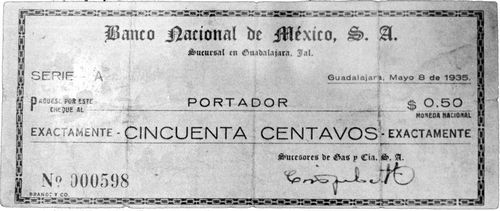
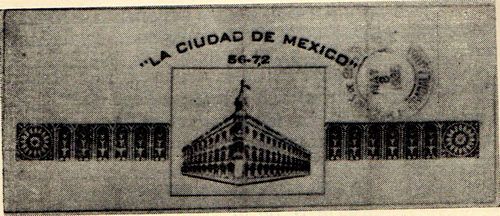
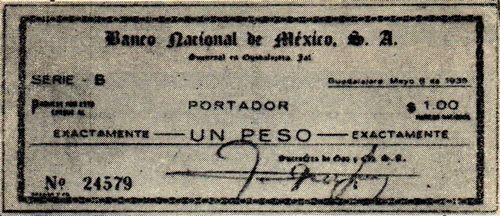
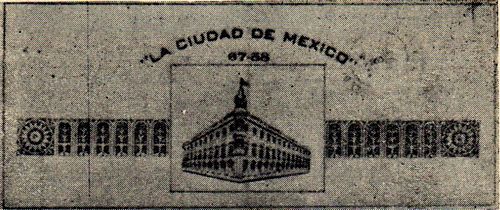
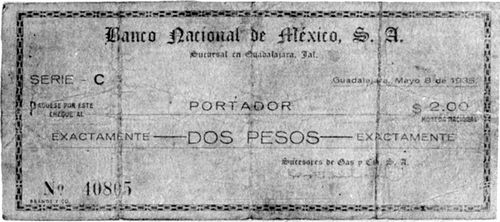
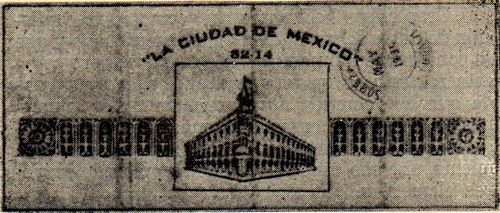
| series | from | to | total number |
total value |
||
| 50c | A | includes number 000598 | ||||
| $1 | B | includes number 24579 | ||||
| $2 | C | includes number 40805 |
The 50c notes (Serie A, blue on yellow,) and the $2 notes (Serie C) were signed by Clovis Aubert, while the $1 notes (Serie B. blue on yellowish green, were signed by J. Teissier.
|
He left “La Ciudad de México” in May 1937El Informador, Año XX, Tomo LXXV, Núm. 7,077, 6 May 1937 and became involved in property development, at a time when the historic centre of Guadalajara was being revamped. In 1940 he bought the Casa RemusThe Casa Remus, on calle del Carmen (today Avenida Juárez) between 16 de Septiembre and Colón, was built in the mid-nineteenth century around 1845, by the architect Jacobo Gálvez, who was also responsible for the Degollado Theatre. It was built for Nicolás Remus, owner of the Haciendas de Bellavista and el Plan, which produced sugar, brandy and mezcal wine (tequila), that were sold there. The façade showed the style of symmetry and perfection both on its balconies, ironwork, cornices, doors and windows typical of Jacobo Gálvez. It is now a branch of McDonald’s. Sic transit gloria mundi. and restored it, with offices in the upper part and shops in the lower part. On 9 June 1947 he was made an alternate member of a Comité de Obras involved with the then widespread development of the centre of Guadalajara. By October 1951 he was the owner of unbuilt land in the heart of the city, on Avenida Juárez, between calle Maestranza and calle Degollado, where he proposed a classy, multi-storey hotel but which the insensitive Ayuntamiento decided to expropriate for a large, modern luxury marketEl Informador, Año XXXV, Tomo CXXVIII, Núm. 11,957, 9 October 1951. By 1945 Aubert was manager of ACYE, S.A. El Informador, Año XXVIII, Tomo CII, Núm. 9,610, 29 April 1945. By June 1949 the workers of ACYE's knitware factory had been on strike for seven months and took out a newspaper advert to highlight their case, that for ten years they had been starved and improverished by a foreigner who had amassed a fortune at their expenseEl Informador, Año XXXII, Tomo CXVIII, Núm. 11,122, 26 June 1949. In December 1953 he inaugurated a new concern, the Central de Medias, on the corner of Avenida Juárez and calle CoronaEl Informador, Año XXXVII, Tomo CXXXVI, Núm. 12,746, 7 December 1953 but he died soon after, on 29 January 1954El Informador, Año XXXVII, Tomo CXXXVII, Núm. 12,799, 7 December 1953. |
 |
| J. Teissier will have been a relative of the major shareholder Benjamin Teisser. |
Unión Nacional de Industria y Comercio
The Unión Nacional de Industria y Comercio was a business club formed to promote commerce that held regular sesiones-agapé with dinners, drinks and lectures. In 1935 it established a Centro Mercantil de Fabricantes at Avenida 16 de Septiembre núm.132-136, the first of its type in the country El Informador, Año XXVIII, Tomo LXVIII, Núm. 6479, 3 September 1935.
On 11 May the Unión Nacional de Industria y Comercio issued $10,000 in cheques, mainly $1 and a few of $2 and $2.50, drawn on the Banco Industrial de Jalisco, and signed by Ernesto Cárdenas Noriega and Manuel Arellano Hernández, or by Ernesto Cárdenas Noriega and Macario G. Zavala. As stated above, only $18 worth was unredeemed.
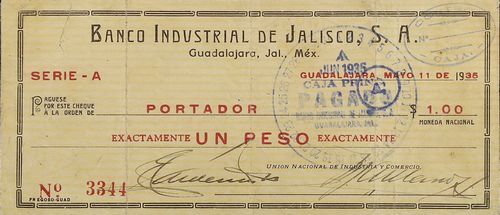
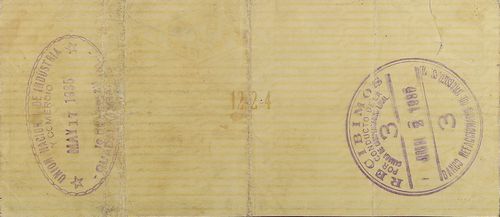
| series | from | to | total number |
total value |
||
| $1 | A | includes number 3344 | ||||
| $2 | ||||||
| $2.50 | ||||||
| $10,000.00 |
|
He established a clothing factory in Degollado and gifted a Casa para la Cultura, la Lectura y las Artes to the town. In 1935 Arellano was secretary of the Unión Nacional de Industria y ComercioEl Informador, 20 August 1935. |
 |
|
In 1935 Cárdenas was treasurer of the Unión Nacional de Industria y ComercioEl Informador, Año XXVIII, Tomo LXVIII, Núm. 6,479, 3 September 1935. |
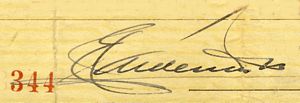 |
|
Macario G. Zavala owned a factory making sweaters and shawls at Medrano 354 with a shop at Avenida 16 de Septiembre núm. 40. He promoted the development of central Guadalajara and on 1 September 1949 opened the edificio Zavala at Pedro Moreno 160, “"one more contribution to the modernization of Guadalajara” “with the capacity to house new commercial establishments, offices for professionals, warehouses, etc.”El Informador, Año XXXII, Tomo CXIX, Núm. 11,190, 2 September 1949. In 1935 he was president of the Unión Nacional de Industria y ComercioEl Informador, 21 June 1935. |
The new Banco de México $1 notes were expected to enter circulation on 15 MayEl Informador, Año XVIII, Tomo LXVII, Núm. 6354, 30 April 1935 but were late. Nevertheless the new notes and bronze coins had been to circulate by 23 May and demand for the Cámara’s cheques had diminished considerablyEl Informador, Año XVIII, Tomo LXVII, Núm. 6376, 23 May 1935.
Ciudad Guzmán
Cámara Nacional de Comercio
| series | from | to | total number |
total value |
||
| 50c | ||||||
| $1 | ||||||
| $2 |
On 2 May the Cámara Nacional de Comercio in Ciudad Guzmán, issued cheques for 50c, $1 and $2, drawn on the Banco Mercantil y Refaccionario de OccidenteEl Informador, Año XVIII, Tomo LXVII, Núm. 6355, 1 May 1935; El Informador, Año XVIII, Tomo LXVII, Núm. 6358, 5 May 1935.
Ocotlán
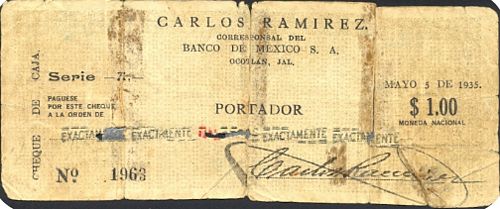
| series | from | to | total number |
total value |
||
| $1 | A | includes number 1963 |
A $1 cheque de caja, dated 5 May 1935, issued by Carlos Ramírez, the correspondent of the Banco de México.
| Carlos Ramírez |  |

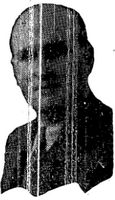
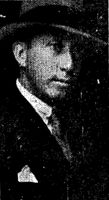 Luis Gonzaga Castañeda y Castaños was born in Guadalajara on 21 May 1892, the son of Ramón Enrique Castañeda y Palomar and Gabriela Castaños y García Granados.
Luis Gonzaga Castañeda y Castaños was born in Guadalajara on 21 May 1892, the son of Ramón Enrique Castañeda y Palomar and Gabriela Castaños y García Granados.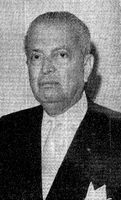 Pedro Martínez Rivas was born in Santa Monica de La Barca, Jalisco, on 1 August 1890, the son of Antonio Martínez García, founder of the Cámara Alimenticia de Jalisco (Jalisco Food Chamber).
Pedro Martínez Rivas was born in Santa Monica de La Barca, Jalisco, on 1 August 1890, the son of Antonio Martínez García, founder of the Cámara Alimenticia de Jalisco (Jalisco Food Chamber).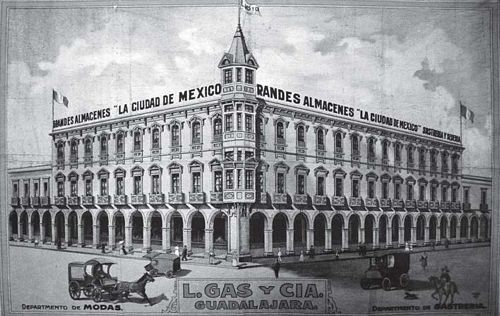
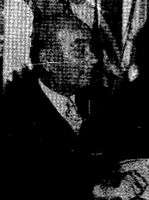 Clovis Aubert Reyne was born in Lurz-Basses-Alpes, France, and was a prominent member of the French community in Guadalajara.
Clovis Aubert Reyne was born in Lurz-Basses-Alpes, France, and was a prominent member of the French community in Guadalajara.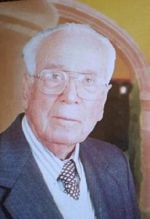 Manuel Arellano Hernández was born in Degollado, Jalisco, on 4 October 1909. He studied in Guadalajara and Mexico City and learnt mechanical electrical engineering in Mexico City and California.
Manuel Arellano Hernández was born in Degollado, Jalisco, on 4 October 1909. He studied in Guadalajara and Mexico City and learnt mechanical electrical engineering in Mexico City and California.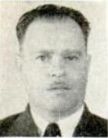 Ernesto Cárdenas Noriega owned “La Silueta”, a factory that made girdles and corsets that were in demand, not only in Guadalajara and Jalisco, but on the west coast and in the interior, including Mexico
Ernesto Cárdenas Noriega owned “La Silueta”, a factory that made girdles and corsets that were in demand, not only in Guadalajara and Jalisco, but on the west coast and in the interior, including Mexico